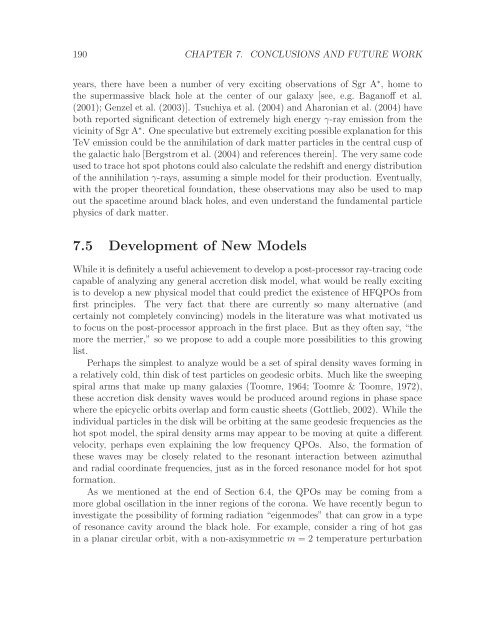Radiation Transport Around Kerr Black Holes Jeremy David ...
Radiation Transport Around Kerr Black Holes Jeremy David ...
Radiation Transport Around Kerr Black Holes Jeremy David ...
Create successful ePaper yourself
Turn your PDF publications into a flip-book with our unique Google optimized e-Paper software.
190 CHAPTER 7. CONCLUSIONS AND FUTURE WORK<br />
years, there have been a number of very exciting observations of Sgr A ∗ , home to<br />
the supermassive black hole at the center of our galaxy [see, e.g. Baganoff et al.<br />
(2001); Genzel et al. (2003)]. Tsuchiya et al. (2004) and Aharonian et al. (2004) have<br />
both reported significant detection of extremely high energy γ-ray emission from the<br />
vicinity of Sgr A ∗ . One speculative but extremely exciting possible explanation for this<br />
TeV emission could be the annihilation of dark matter particles in the central cusp of<br />
the galactic halo [Bergstrom et al. (2004) and references therein]. The very same code<br />
used to trace hot spot photons could also calculate the redshift and energy distribution<br />
of the annihilation γ-rays, assuming a simple model for their production. Eventually,<br />
with the proper theoretical foundation, these observations may also be used to map<br />
out the spacetime around black holes, and even understand the fundamental particle<br />
physics of dark matter.<br />
7.5 Development of New Models<br />
While it is definitely a useful achievement to develop a post-processor ray-tracing code<br />
capable of analyzing any general accretion disk model, what would be really exciting<br />
is to develop a new physical model that could predict the existence of HFQPOs from<br />
first principles. The very fact that there are currently so many alternative (and<br />
certainly not completely convincing) models in the literature was what motivated us<br />
to focus on the post-processor approach in the first place. But as they often say, “the<br />
more the merrier,” so we propose to add a couple more possibilities to this growing<br />
list.<br />
Perhaps the simplest to analyze would be a set of spiral density waves forming in<br />
a relatively cold, thin disk of test particles on geodesic orbits. Much like the sweeping<br />
spiral arms that make up many galaxies (Toomre, 1964; Toomre & Toomre, 1972),<br />
these accretion disk density waves would be produced around regions in phase space<br />
where the epicyclic orbits overlap and form caustic sheets (Gottlieb, 2002). While the<br />
individual particles in the disk will be orbiting at the same geodesic frequencies as the<br />
hot spot model, the spiral density arms may appear to be moving at quite a different<br />
velocity, perhaps even explaining the low frequency QPOs. Also, the formation of<br />
these waves may be closely related to the resonant interaction between azimuthal<br />
and radial coordinate frequencies, just as in the forced resonance model for hot spot<br />
formation.<br />
As we mentioned at the end of Section 6.4, the QPOs may be coming from a<br />
more global oscillation in the inner regions of the corona. We have recently begun to<br />
investigate the possibility of forming radiation “eigenmodes” that can grow in a type<br />
of resonance cavity around the black hole. For example, consider a ring of hot gas<br />
in a planar circular orbit, with a non-axisymmetric m = 2 temperature perturbation
















